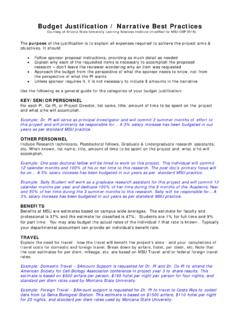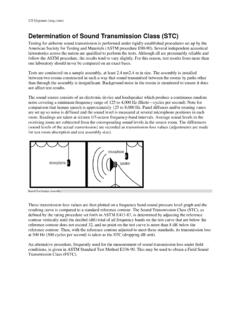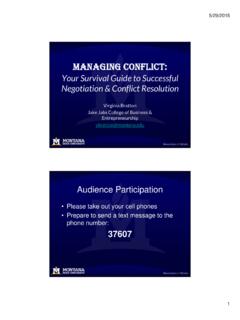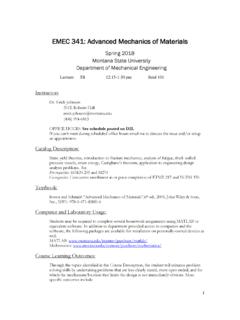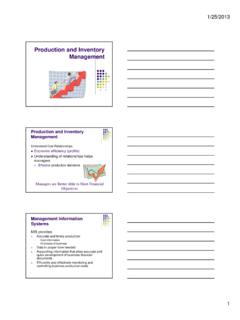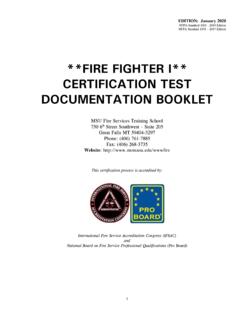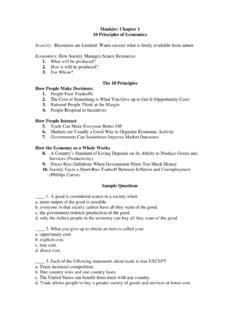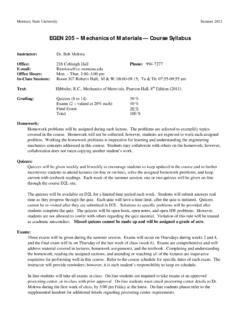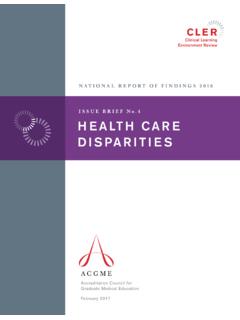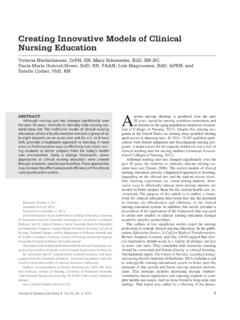Transcription of Family Nurse Practitioner Option Master of Nursing ...
1 Family Nurse Practitioner Option Master of Nursing Graduate Degree Program clinical Manual 2012-2013. Reviewed June, 2012. Associate Dean for Research and Graduate Education TABLE OF CONTENTS Introduction .. 1 Goals of clinical Experience .. 1 Appropriate clinical Sites .. 1 Who Can Act as a Preceptor .. 2 Preceptor Interview .. 2 Scheduling of clinical Hours .. 2 Attendance .. 3 Professional Dress and Behavior .. 3 clinical Placement .. 3 Preparation .. 3 Placement Process .. 4 Compliance Care .. 4 Documentation .. 5 clinical Hours .. 5 clinical SOAP Notes .. 5 Skills List .. 5 Preceptor Evaluation of the Student .. 5 Purposes of Preceptor Feedback/Evaluation .. 6 Student Evaluation of Preceptor .. 6 Primary Care Forms .. 6 Montana Area Health Education Centers ..6 Looking for a clinical Site? Go Rural .. 6 Certification References .. 9 clinical Placement Plan .. 10 Record of FNP Student's clinical Hours .. 11 Confidentiality Agreement (HIPPA).
2 12 clinical Faculty Reference Guide .. 13 clinical Skills and Procedure List .. 14 Introduction Welcome to Montana State University College of Nursing Family Nurse Practitioner graduate Option ! This manual serves as a guide for FNP Option graduate students to achieve successful clinical experiences. The manual outlines student responsibilities for: clinical preparation and placement Scheduling clinical hours Establishing clinical objectives Proper documentation Goals of the clinical Experience 1. Expand student's exposure to clinical situations, strategies and variety of treatment modalities. 2. Provide the opportunity to apply theory. 3. Work with and learn from experienced clinician as a preceptor. 4. Develop and expand expertise in clinical skills. 5. Expand knowledge about how clinical sites operate. 6. Develop knowledge of the financial aspects of primary health care practice. 7. Expand experience in the care of families in primary health care.
3 8. Provide opportunities for collaboration with other disciplines in the provisions of health care services. Appropriate clinical Sites To prepare for the best clinical experiences, students will complete and send to the FNP clinical Coordinator (Deanna Babb) a clinical plan in September of their first year of graduate study (see clinical Placement Plan page 10). To facilitate the clinical placement and paperwork process, a current short- form vitae is required from each preceptor. clinical experiences with preceptors that are observational such as radiology do not need a vita. A new vita is required from preceptors on a yearly basis. If needed, a Preceptor Short Form Vita is available online at: Please limit preceptors to 1 or 2 per semester for consistency and a richer learning experience. NRSG 561 (135 hours) - - NRSG 561 Primary Care I requires 2 preceptors. Two- thirds of the semester (approximately 9 weeks or 81 hours) is spent with a pediatric clinician or a Family practice clinician who has a large pediatric practice and one- third (6 weeks or 54 hours) of the semester is spent with a clinician whose focus is care of women during pregnancy.
4 A Family practice that cares for patients across the lifespan is also acceptable for this full clinical experience. NRSG 562 (135 hours) - - The focus of NRSG 562 Primary Care II is the midlife Family . The student will expand H&P skills and broaden the scope of diagnostic and treatment plans. Students begin to develop an understanding of the scope and complexity of the FNP role. 1. NRSG 563 (135 hours) - - NRSG 563 Primary Care III introduces the student to the complexities of elder care. The student will continue to expand H&P skills and develop treatment plans that involve diagnoses and recognition and use of poly- pharmacy. NRSG 571 (270 hours) - - The goal of NRSG 571 Primary Care IV is to enable the student to progress from a novice to a more expert level of clinical skill and decision- making. Students frequently request clinical sites that are congruent with post graduation career goals. Who Can Act as a Preceptor? Nurse Practitioners - - Nurse Midwives Physician Assistants Actively involved in clinical practice Nationally certified as an NP, CNM, or PA Hold Master 's degree with at least 1 year of clinical experience.
5 Recognized as an APRN in Montana with prescriptive authority OR recognized as APRN meeting federal guidelines. [Federal facility requirements at VA clinics, military, US Public Health Service Corps (USPHSC), etc] Physicians Actively involved in clinical practice. Board certified preferred Licensed in Montana as MD, DO or recognized as MD/DO meeting federal guidelines. Preceptor Interview Some preceptors request an interview with the student. The interview: 1. provides the preceptor with an understanding of the level, ability, and personality of the student; and 2. enables the preceptor to assess if the student would be a good fit for the clinical site and the population it serves. Remember you are a guest in the clinical practice. The preceptor has the right to make a decision about whether you are a good match for that particular practice. Scheduling of clinical Hours clinical practicum hours are to be scheduled at the convenience and availability of the preceptor.
6 Students are not to ask preceptors to conform to a schedule that meets their personal and employment needs. The student's personal and work schedules are expected to accommodate the required number of clinical hours prescribed by the clinical course. Prior to beginning the practicum experience, students and preceptors need to agree on the days and times that the student will be in the clinical agency. Each Primary Care course requires 9 clinical hours per week or 135 total hours except NRSG 571 Primary Care IV which requires 270 total clinical hours over 15 weeks or approximately 18 hours per week. It is also acceptable to complete several clinical days in a row. For example, clinical sites obtained through Area Health Education Center (AHEC) encourage students to complete clinical 2. hours a week or more at a time. Many of these sites are at rural health clinics or critical access hospitals. They may also pay for travel and provide food and lodging.
7 Attendance It is the student's responsibility to monitor the number of clinical hours. Extension of the clinical experience with the preceptor cannot be assumed. Unexpected illness of the student, Family and/or preceptor should be discussed with clinical faculty and the parties involved. Failure to notify the preceptor as negotiated is unacceptable and may place the student and clinical placement in jeopardy. Absences resulting in lost clinical hours must be completed before the end of the semester and at the convenience of the preceptor. Professional Dress and Behavior Students present themselves as ambassadors of Montana State University, the College of Nursing and the graduate program. Students are expected to be respectful to preceptors, faculty, staff, patients and their families. Reports of unprofessional behavior will result in the student being counseled and is subject to review by the College of Nursing Associate Dean for Research and Graduate Education.
8 Refer to College of Nursing (CON) Policy D- 3 clinical Performance in Required Graduate clinical Nursing Courses. Students should be dressed professionally ( clinical site- specific attire) and wear a student nametag that meets State Board of Nursing requirements. Each student is required to send his or her preceptor/s a thank you note using College of Nursing letterhead (letterhead can be obtained from your campus administrative assistant). A copy of the letter must be given to the clinical faculty and will be included with the final course evaluation. clinical Placement Preparation 1. Students are expected to have full knowledge of agency requirements for the clinical practicum (orientation, dress, location, schedule, etc.) before scheduling the first clinical day. 2. On the first clinical day discuss questions about orientation, computer access, the procedure for cosigning documents, communication with other disciplines, eating, parking arrangements, etc.
9 3. Learn something about the preceptor, when possible, in order to acknowledge the preceptor's background and broaden the student's educational experience. Placement Process 1. Complete the Graduate clinical Placement Plan and Timeline (page 10) and return to the FNP clinical Coordinator (Deanna Babb) by September 30th of first semester. 3. 2. Meet with your assigned clinical faculty at the beginning of the semester preceding the semester of the clinical course. For example, to plan experiences for the spring semester, meet with faculty in the beginning of the fall semester. Review your goals, strengths and weaknesses. Discuss your ideas for clinical sites and potential preceptors. If needed, meet with your clinical faculty again for assistance. It is best to develop a clinical plan through all the clinical experiences to secure the best possible experience. 3. Contact the potential preceptor by phone or letter of introduction. You will need to know: a) When the course begins and ends b) How many clinical hours you will be spending with the preceptor c) Days/hours that you are NOT available ( , class days, holidays, work) 4.
10 Obtain the preceptor's vita or resume and send the vita to the FNP clinical Coordinator (Deanna Babb), by email or fax or faxed to 406- 771- 4449). Please do not send this information via D2L. 5. Kay Lawhon, Administrative Associate (406- 771- 4450), will prepare a preceptor packet to include an agency agreement, if applicable, signed by the Dean of the College of Nursing . The complete packet will be sent directly to the student to take to the clinical agency and preceptor. The preceptor packet contains an introductory preceptor letter, agency agreement signed by Dean Melland (when applicable), course description/objectives and student evaluation form. 6. The student will be responsible for: a) Obtaining the preceptor's vita b) Sending the preceptor's vita to the FNP clinical Coordinator (Deanna Babb) c) Delivering the preceptor packet to the preceptor d) Obtaining a signature on the agency agreement (AA) e) Returning the signed agency agreement to Kay Lawhon before beginning the clinical experience.
